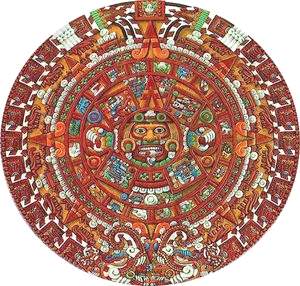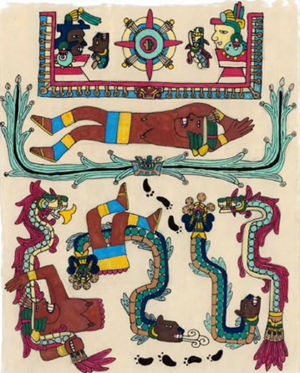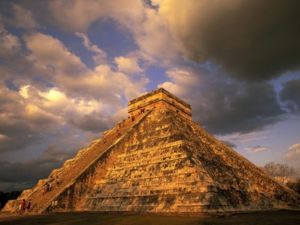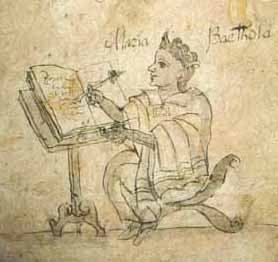The Blood Cult: Difference between revisions
m (Moved to lost religion) |
|||
| (3 intermediate revisions by 2 users not shown) | |||
| Line 1: | Line 1: | ||
'''''By order of the Third Teocoatl, Cultist lore and mythology has now been made available to outsiders. Mail will only be collected at temples, however.''''' | '''''By order of the Third Teocoatl, Cultist lore and mythology has now been made available to outsiders. Mail will only be collected at temples, however.''''' | ||
{{Infobox Blood Cult}} | {{Infobox Blood Cult}} | ||
[[Category:The Blood Cult| ]] | |||
==Introduction== | ==Introduction== | ||
The Blood Cult, as it has come to be known, is an organized faith with an elaborate pantheon, myths, traditions, and overall set of beliefs. Despite it's grim appearance and connotation to strangers, it is a highly romantic religion, one that values life, beauty, knowledge. The faith spawned in Beluaterra, during a time of crisis for the world. Though the original inspiration came before, it consolidated itself with the omnipresent disasters: first the starvations on the East Continent, then the hellish invasion on Beluaterra, both of which killed countless people from all over, a dramatic event which needed to be given some meaning. | The Blood Cult, as it has come to be known, is an organized faith with an elaborate pantheon, myths, traditions, and overall set of beliefs. Despite it's grim appearance and connotation to strangers, it is a highly romantic religion, one that values life, beauty, knowledge. The faith spawned in Beluaterra, during a time of crisis for the world. Though the original inspiration came before, it consolidated itself with the omnipresent disasters: first the starvations on the East Continent, then the hellish invasion on Beluaterra, both of which killed countless people from all over, a dramatic event which needed to be given some meaning. | ||
| Line 44: | Line 44: | ||
! align="center" style="background:#621D1D;" |<span style="color: white">Parents</span> | ! align="center" style="background:#621D1D;" |<span style="color: white">Parents</span> | ||
! align="center" style="background:#621D1D;" |<span style="color: white">Heritage</span> | ! align="center" style="background:#621D1D;" |<span style="color: white">Heritage</span> | ||
|- | |- | ||
! align="center" style="background:#621D1D;" |<span style="color: white">Caraoatl</span> | ! align="center" style="background:#621D1D;" |<span style="color: white">Caraoatl</span> | ||
| Line 258: | Line 249: | ||
*[[The Blood Cult/Fourth Invasion|New Age]] | *[[The Blood Cult/Fourth Invasion|New Age]] | ||
*[[The Blood Cult/Cuachitl of Light|Cuachitl of Light]] | *[[The Blood Cult/Cuachitl of Light|Cuachitl of Light]] | ||
[[Category:Lost Religions of Beluaterra|Blood Cult]] | |||
Latest revision as of 13:37, 28 September 2018
By order of the Third Teocoatl, Cultist lore and mythology has now been made available to outsiders. Mail will only be collected at temples, however.
Introduction
The Blood Cult, as it has come to be known, is an organized faith with an elaborate pantheon, myths, traditions, and overall set of beliefs. Despite it's grim appearance and connotation to strangers, it is a highly romantic religion, one that values life, beauty, knowledge. The faith spawned in Beluaterra, during a time of crisis for the world. Though the original inspiration came before, it consolidated itself with the omnipresent disasters: first the starvations on the East Continent, then the hellish invasion on Beluaterra, both of which killed countless people from all over, a dramatic event which needed to be given some meaning.
Core Values
- Main Article: Doctrine
The faith is one which attributes a very high value to life. If fact, like many animist and shamanic traditions, most of it's rituals are oriented toward thanking or pleasing these nature gods. Like many faiths encourage a form of self-sacrifice to come closer to their gods, followers of the faith bring it one step further with sacrificing what they hold most precious, life itself, with the concept that it is better to sacrifice a few for the many than let the collective needs of the individuals hamper the good of the many. The concept lies on the flow of blood, in an analogy comparing the world much to any form of living body: movement brings warmth, life, stagnation brings cold and death. Without a beating heart (and therefore without a pulse or flow of blood), a body cools down and dies, decays, therefore, blood must be spilled regularly on this world if we don't want it to stagnate.
The cult has a very relativist philosophy, and does not believe in "good" and "evil" in their traditional sense. For cultists, there is but the will of the gods, and you either serve them or you oppose them. But as the gods can have varying goals and methods, actions can be considered "good" in some circumstances and "bad" in others. The only moral absolute of the cult is that the gods are our creators and that we owe them everything, though some sects have developed on this to create further rules.
It also desires to explain and document all aspects of the world that surrounds it. As such, as many great disasters as possible are documented and explained according to theology, and priests strive to uncover the secrets of the mystical elements of the world: undead, daimons, monsters, lighting, etc. As such, some gods are described and accepted despite not being worshipped, and many cultists have been seen in the presence of loathed creatures in order to better understand and influence them.
History
- Main Article: History
The history of the Blood Cult can be somewhat long and complex, depending on how one desires to approach it. Myths and official history date from way before any written document that can be found today and so many written documents go way before the founding of the Blood Cult, since the cult tends to adopt mythology and rituals from various pagan origins with the belief that paganism is really but the regionalization of a single greater faith from long ago. Furthermore, the faith had two foundings, one with the discovery of an ancient tomb temple in the mountains of Gaxano, and a second which a much different revised pantheon and mythology from the badlands of Coness, following a vision by Louis-Joseph and accounting for the great amount of research he had conducted since the first founding. As such, the Cult can be seen as having many origins, and this must be taken into consideration when studying its history.
Throughout time, the Blood Cult has had influence, nobles, and/or temples in regions of Avalon, Bara'Khur, Enweil, Fronen, Heen, Hetland, Khthon, Melhed, Netherworld, Old Grehk, Republic of Fwuvoghor, Riombara, and Thalmarkin. However, these did not usually stand out, and often they came and went without the realms ever realizing it, as the Cult is a mostly non-aggressive faith at its origin. Following persecution, though, the faithful have banded on many occasions to cast down those who oppressed and persecuted them, but such actions were only after grave events and continuous mistreatment, the assimilating nature of the Cult making them loath to pass judgment on other religions when these seem authentic and aren't mere political tools, for which the Cult has little sympathy.
Rituals
- Main Article: Rituals
Sacrifices
Sacrifices lay at the core of the religion, as the flow of blood is bringer of life, and blood must be spilled for the sun to rise every morning (and therefore allow plant life, and life in general). Hangings and looting can be tools to collect the victims, as can foreign adventurers, depending on the realm in which it is done. In realms where the laws seriously restrict ritual killings, the faithful often have to contend themselves will sacrificing criminals who have been sentenced to death for their misdeeds, and as such torture and execution has become a speciality of some for the rituals are usually quicker when greater freedom is accorded.
A noble that offers his body to the gods is the greatest gift that can be done for them, as long it the proper ceremony accompanies it, such as a religious recreation of one of the myths.
Other form of sacrifices, animal, food, riches, or basically anything, can also be done, depending on the god.
Rite of Initiation
The practitioners of the Cult share what some may consider exotic beliefs, which has the tendency of isolating them from the rest of the world. However, from this, the cultists have learned to bring themselves closer together, and elaborate tighter ties with each other. One of the means to do this is the rite of initiation.
The cult doesn't satisfy itself with names on a list to show around, as such, they want to make all their followers, especially the nobles, involved in the religion's affairs. As such, aspirants seeking full membership, and all of the benefits that it grants, are expected to assist a priest in a ritual killing, where the aspirant will be expected to execute the victim. After this, the priest inscribes on a visible part of the aspirant's body a tattoo, through a painful process. Once this is finished, the noble is officially a member of the community, and there is cause to celebrate.
Pantheon
- Main Article: Sects
| ||
| Continent / Island | Beluaterra | |
| Main Temple | (None) | |
| First Temple | Coness, Small Temple (Lvl. 3) | |
| Last Updated | 02:39, 23 August 2008 (CEST) | |
| Name | Status | Aspects | Dominions | Gender | Variant Forms | Parents | Heritage |
|---|---|---|---|---|---|---|---|
| Caraoatl | Dead | Jealousy, Violence, Sacrifice, Creation | None | Male | Volcano | Icalotl/Izalotl | Xelatl |
| Cazoatl | Alive | Corruption, Waste | None | Male | Clouds, Blob | Caraoatl/(None) | Xelatl |
| Dagotl (Da Great Goat) | Alive | Humour, Entertainment, Festivities | Thalmarkin | Male | Goat | Unknown | Xenotl |
| Foatl | Dead | Lust, Fertility, Love | None | Female | None | Icalotl/Izalotl | Xelatl |
| Hiacaotl | Alive | Teaching, Initiative, Ambition | None | Female | Serpent | Icalotl/Izalotl | Xenotl |
| Icalotl | Dead | Male part of Isolotl | None | Male | Seas | (Isolotl) | (Isolotl) |
| Isolotl | (Isolotl) | Primal god of Duality | None | Both | None | None | Source |
| Itzpapalotl (Dark Mistress) | Captive | Trials, Innovation, Fire, Death, Undeath | Melhed | Female | Undead, Moth | Xunaotl/Dirt | Xenotl |
| Izalotl | Dead | Female part of Isolotl | None | Female | Continents | (Isolotl) | (Isolotl) |
| Jacotl (Wolf Lord) | Alive | Strength, War, Justice | Fronen | Male | Jaguar, Wolf | Icalotl/Izalotl | Xenotl |
| Motl | Alive | Labour, Charity | None | Male | Moon | Icalotl/Izalotl | Xenotl |
| Nethitlpl (Great Dragon/Daimon) | Dead (beheaded) | Obediance, Tributes, Gatekeeping, Second Chances, Daimons, Matriarchy | Mount Nethitlpl | Female | Dragon, Daimon | Unknown | ???? |
| Teatoatl | Dead | Lust, Punishment | None | Male | None | Icalotl/Izalotl | Xelatl |
| Xeatoatl | Dead | Fire, Carelessness, Incompetance | None | Male | Stars | Icalotl/Izalotl | Xelatl |
| Xerotl (Teros) | Alive | Strength, Order, War, Shadows | Monarchist Fwuvoghor | Male | Serpent | Man/Chaos | Xenotl |
| Xunaotl | Alive | Seduction, Fertility, Care | None | Female | Sun | Icalotl/Izalotl | Xenotl |
| Yohuatocatl | Alive | Lust, Murderous Instinct, Shadows, Illusions | None | Female | Spider | Unknown | Xelatl |
Xelatl and Xenotl
In the myth of creation, the Xenotl are described as the first batch of gods to have spawned, which eventually chased down and slew the original Xelatls, who were the second batch. However, the difference is greater than simply this, and it is sometimes hard to trace down new gods' origins to the original 8. To put it simply, the Xenotls are worshiped and praised in order to gain their favour, for example, to have the sun rise every day. On the other side are the Xelatl, which we must please in order to prevent something to be inflicted, for example, to prevent an epidemic.
For a clearer picture, we can compare a Xelatl god of death to a Xenotl god of death: While you would offer sacrifices to the Xenotl in order to commune with the dead, or to bring someone back, you would please the Xelatl in order to convince him not to make everyone in your village drop dead.
Myths
- Main Article: Myths
Creation Myth
In the beginning, there was nothing at all. From the void came Isolotl: who was nothing, yet was everything. He was none and all at once, female and male, creation and destruction, heat and cold, good and evil: Isolotl was the being of duality. And so, for a very long time, Isolotl was the world and the world was Isolotl. Then, he became Icalotl and Izalotl and conceived the first litter of divinity, the four Xenotls: Xunaotl, Motl, Hiacaotl, and Jacotl.
For 400 years they lived together, until Izatol became pregnant again. The children could not accept others taking their place, so they decided to go and kill their parents. Hiacaotl transformed into a snake and constricted Icalotl while Jacalt transformed himself into a jaguar and tore him apart, and turned him into in the oceans. They then went to find their mother Izalotl, but she had gotten away and gave birth to four new children, the Xelatls: Faotl, Xeatoatl, Teatoatl, and Caroatl. The four Xenotls, however, quickly found her and killed her, but were surprised by the new children, fully grown-up and equipped, and were forced to flee, wounded. The body of the Izalotl became the continents.
With the Xenotls gone yet still alive, the Xelatls decided to create an order to rule the world. Faotl jumped in the water, and from it she formed the first humans, to serve and ward them from the Xenotls. Xeatoatl decided to become the sun and shine over the world, however he could not move and he scorched Faotl's creation, which angered the other gods. Teatoatl killed him, shattering him into pieces which became the stars, and took his place. The few humans who had survived returned to the sea as turtles. This time, Faotl used the sun's fire and created new humans. Caraoatl soon discovered that Teatoatl was fooling around with Faotl, and so he decided to kill him. Before he took his place, Faotl turned Teatoatl into the moon to remember him forever. Humans once again mostly withered away, those who survived became the birds. Faotl made humans from dirt this time, and they once again prospered. However, Caraoatl eventually discovered that she was still going to see the moon and that she still loved Teatoatl, so in his rage he scorched her and her new creations, wich turned into monkeys. Alone, he molded the world as he saw fit, creating humans from a bit of his own blood.
Caraoatl being the only Xelatl left, the Xenotls gathered once more and returned to slay him. To kill him, they sent Xunaotl to seduce him. The trick worked, and when Caraoatl was distracted, Molt impaled him, driving his spear through Caraoatl's heart and sending him down on earth. He became a bleeding volcano, and his humans became lizards. However, with his last strength, he burned Xunaotl for her treachery, and cursed her, and all other Xenotls, that they would forever require blood to survive.
The fourth age was done, and so the Xenotls had to think of a way to battle the curse. Xunaotl used Faotl's bones and her own blood and formed the humans that still live today, that would forever be nurtured and that would forever nurture the gods. They now needed a sun so that their creations could survive, as to avoid jealousy they decided the crippled Xunaotl should take the role so they extracted her heart and set it in the sky, which formed the friendliest sun the world had known. However, they were surprised to see that the moon, unlike the new sun, remained still in the skies, and so Motl, to keep it out of his sister's way, volunteered to carry it through the skies: returning it when his sister rested and hiding it when she returned. Hiacaotl and Jacotl thus remained to teach and train humanity.
Archives
Though the Cult has a long militaristic tradition, it is also has a strong emphasis on culture and knowledge which are the pillars of the faith. As such, it has an important and ever-growing system of libraries, the main one holding various kinds of rare and original documents in addition to official cultist lore, while the smaller ones work hard at replicating the documents to have as many copies available as common to pass around the various centres. In addition to research notes, original and ancient tomes and scrolls, and cultist lore, there are large sections with various texts on the other religions of the world (defunct and active), though the content being mostly limited to the faiths of Beluaterra at this time. Essays on the mundane realms can also be found with general descriptions and statistics, with focus on geographical and cartographic documents along with cultural works of literature, music, theatre and so on.
Writings
Influential essays and correspondences that have shaped The Blood Cult's beliefs.
- On Daimons
- On the Daimons and Undead
- Writings - Generic writings
- Old Gods correspondences - Correspondences between Teocoatl Louis-Joseph and Augur Nawat of the Old Gods.
Records
Records of various events, most importantly of all initiations followed through by every faithful of the cult.
Documentation
All various documents that do not stem directly from the gods as currently understood by the Blood Cult.





